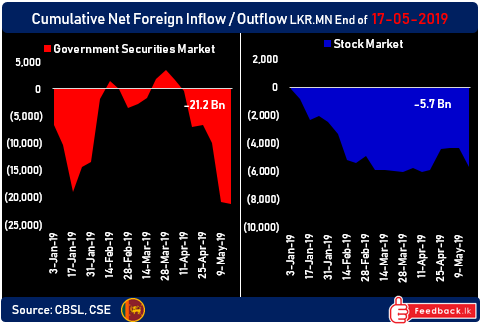May 17, 2019 (LBO) - Foreign institutional investors were net sellers of Sri Lankan equities for the past three consecutive days as the country's largest pension fund entered the market after a long hiatus.
Net foreign selling in Sri Lanka's stock market was approximately Rs1.
3bn (US$7.5mn) for the past week. Year to date net foreign selling stands at Rs5.7bn (US$32mn).
Trading on the Colombo Stock Exchange (CSE) was extraordinarily light for the first few days of the week, with a pick up on Friday following confirmation from the Central Bank Governor that Sri Lanka's largest pension fund, the Employees Provident Fund (EPF), had recently made purchases in the stock market.
In a move that was long telegraphed and done after much deliberation, Sri Lanka's EPF decided to increase its portfolio allocation of equites past the previous cap of 5%.
The EPF has a total portfolio over over USbn, with over 90% of funds invested in fixed income.
Fixed income securities in Sri Lanka have historically delivered attractive returns that have significantly outperformed the EPF's investments in the stock market or private equity.
Trading in the stock market picked up on Friday with US$8mn worth of shares transacted. Much of the trading was foreign selling with speculation that foreign institutions were selling shares to the EPF.
The bulk of the day's trading was in shares of Dialog Axiata (DIAL) and John Keells Holdings (JKH), both shares that are on the EPF buying list.
buy zovirax online buy zovirax online no prescription
Sri Lanka's bond market has also seen foreign outflows on the year, however the pace of the outflows moderated in the past week with just a few million dollars of net foreign selling.
Sri Lanka's currency has been relatively stable at near Rs176 to the dollar.
Relative strength in the currency is likely due to a significant reduction in imports as a result of the Easter Sunday terror attacks and the prevailing tense security situation. The reduction in imports is likely mitigating the pressure caused by capital outflows and the reduction in tourism revenue.

